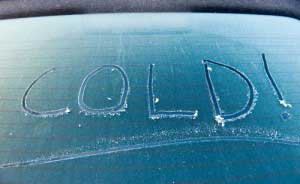Cold Urticaria And Cold Allergy: Not A Joke!

I’ve often joked around with my patients during this brutally cold northeast winter that “I’m allergic to the cold!” The dark, cold winter days are tough can be hard to get through both mentally and physically. However, I don’t want to belittle the existence of cold allergy, because it does really exist!
Cold Urticaria
The medical term, cold urticaria, refers to the condition where a patient that is exposed to cold air or water develops hives (urticarial) and even swelling (angioedema).
This can be a very frightening condition. If a patient with cold urticaria goes outside in this current bitter cold weather without gloves, a scarf, and a ski mask, by the time they get indoors they may find the following things have happened:
- Their hands have swollen
- They have hives on their neck and face
- They have swollen lips.
Precautions You Can Take
Medical research is not sure why patients get this condition, although there is a genetic type. The good news is that it is benign (not harmful), but patients must take special precautions to avoid disaster.
For example, a patient with cold urticaria should never, under any circumstances, take the Polar Bear plunge. The Polar Bear plunge refers to those crazy swimmers who go into the ice-cold water in Brooklyn in January, just for fun! If a person with cold urticaria did this, it would cause a life-threatening reaction.
Patients with cold urticaria also need to be careful with cold drinks, as this can cause swelling in the throat.
The Ice Cube Test
The simple test for these patients who aren’t sure whether they have this condition is called the Ice Cube Test. With this test, the doctor places an ice cube on the patient’s forearm for one minute; the ice cube is taken off and observed.
The skin won’t start to welt or swell until it starts to rewarm. This will take at least 15 minutes from when the ice is removed, so if you do the test and don’t wait, you can miss the diagnosis.
The other good news is that an older type of antihistamine called cyproheptadine is especially effective at preventing and reducing symptoms if cold exposure is unavoidable.
Cold-Induced Asthma

Cold-induced asthma is a similar but unrelated concept to cold urticaria. Patients can show no signs of their asthma, but if they go out in very cold weather they may start wheezing.
The key is to make sure you cover your mouth with a scarf and breathe through your nose. The reason for this is when you breathe through your nose, the nasal passages warm the air before it reaches the lungs. However, if you breathe through your mouth, the cold air can trigger bronchial spasms in asthmatic patients.
Raynaud’s Phenomenon
The other common reaction that can occur in cold weather is the development of Raynaud’s phenomenon. Raynaud’s is also considered a benign condition, where individuals start to get numbness in their extremities (hands and feet) when they are exposed to very cold weather.
The typical reaction is almost patriotic: first, the hands turn white, then as it worsens they turn blue and finally when the hands or feet re-warm, blood gushes back under the skin and it turns red. This condition can be quite painful in the cold weather months, so precautionary measures make a lot of sense.
I sympathize with my patients that suffer from cold urticaria and other cold-induced allergic diseases, but in one way I’m jealous: what a great excuse to move to California or Arizona for the winter!
Dr. Dean Mitchell
Mitchell Medical Group, NYC & Long Island

